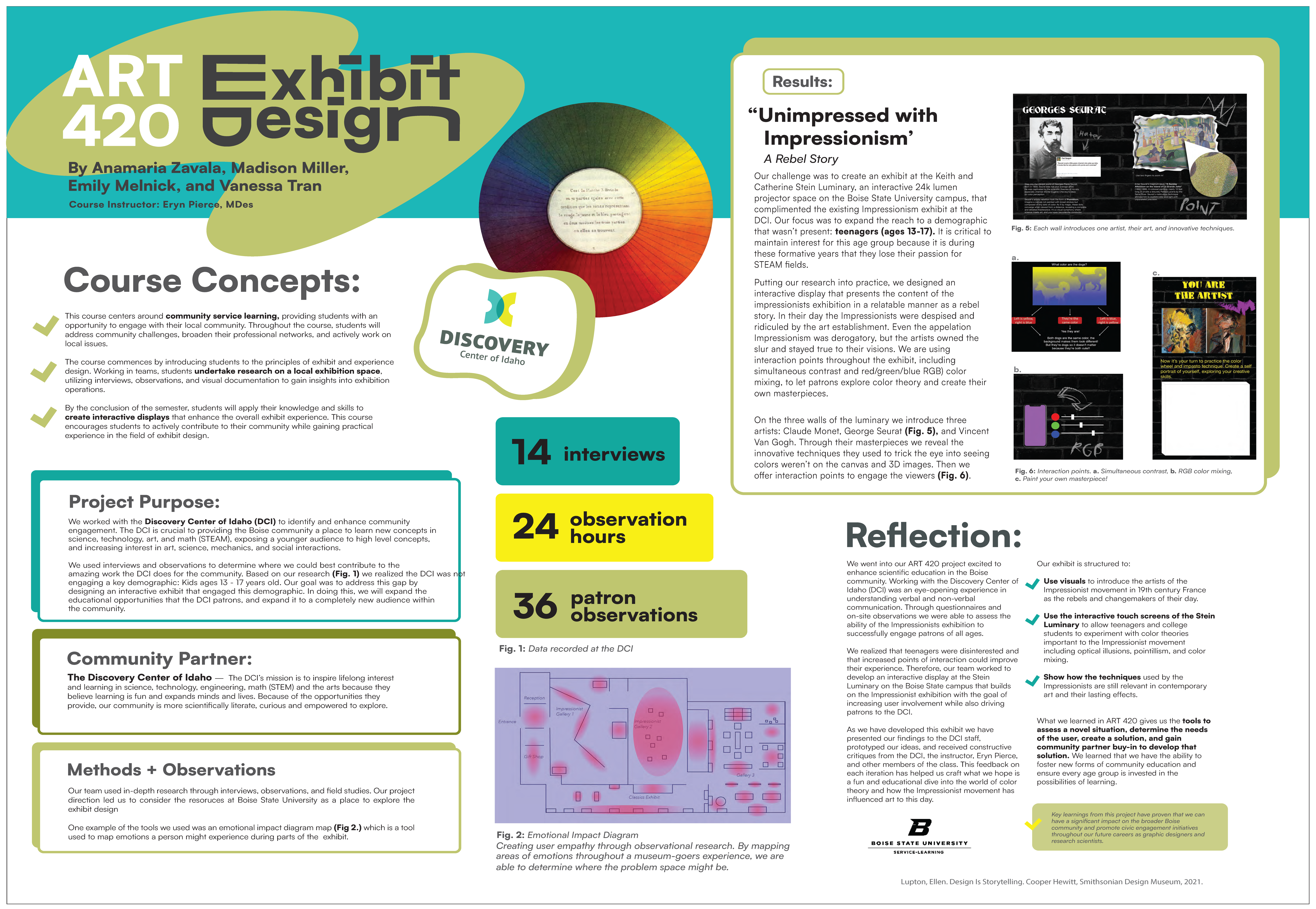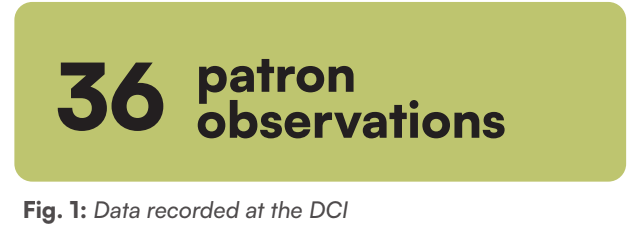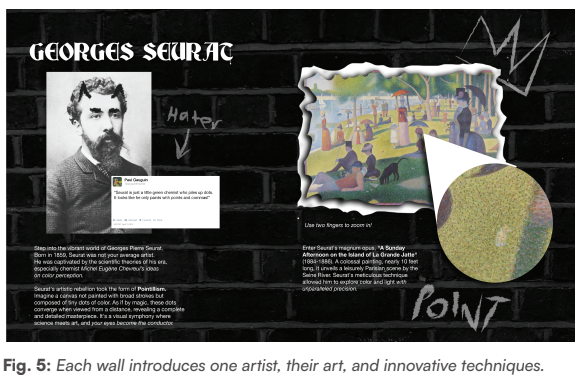Emily Melnick, Madison Miller, and Vanessa Tran, Anamaria Zavala
Eryn Pierce MA – ART 420
Discovery Center of Idaho (DCI)

Introduction:
Reflection
We went into our ART 420 project excited to enhance scientific education in the Boise community. Working with the Discovery Center of Idaho (DCI) was an eye-opening experience in understanding verbal and non-verbal communication. Through questionnaires and on-site observations we were able to assess the ability of the Impressionists exhibition to successfully engage patrons of all ages.
We realized that teenagers were disinterested and that increased points of interaction could improve their experience. Therefore, our team worked to develop an interactive display at the Stein Luminary on the Boise State campus that builds on the Impressionist exhibition with the goal of increasing user involvement while also driving patrons to the DCI.
As we have developed this exhibit we have presented our findings to the DCI staff, prototyped our ideas, and received constructive critiques from the DCI, the instructor, Eryn Pierce, and other members of the class. This feedback on
each iteration has helped us craft what we hope is a fun and educational dive into the world of color theory and how the Impressionist movement has influenced art to this day.
Our exhibit is structured to:
Use visuals to introduce the artists of the Impressionist movement in 19th century France as the rebels and changemakers of their day.
Use the interactive touch screens of the Stein Luminary to allow teenagers and college students to experiment with color theories important to the Impressionist movement including optical illusions, pointillism, and color mixing.
Show how the techniques used by the Impressionists are still relevant in contemporary art and their lasting effects.
What we learned in ART 420 gives us the tools to assess a novel situation, determine the needs of the user, create a solution, and gain community partner buy-in to develop that solution. We learned that we have the ability to foster new forms of community education and ensure every age group is invested in the possibilities of learning.
Community Partner: Discovery Center of Idaho
Mission Statement:
The DCI’s mission is to inspire lifelong interest and learning in science, technology, engineering, math (STEM) and the arts because they believe learning is fun and expands minds and lives. Because of the opportunities they provide, our community is more scientifically literate, curious and empowered to explore.
Project Purpose/Community Identified Need:
We worked with the Discovery Center of Idaho (DCI) to identify and enhance community engagement. The DCI is crucial to providing the Boise community a place to learn new concepts in science, technology, art, and math (STEAM), exposing a younger audience to high level concepts, and increasing interest in art, science, mechanics, and social interactions.
We used interviews and observations to determine where we could best contribute to the amazing work the DCI does for the community. Based on our research (Fig. 1) we realized the DCI was not engaging a key demographic: Kids ages 13 – 17 years old. Our goal was to address this gap by designing an interactive exhibit that engaged this demographic. In doing this, we will expand the educational opportunities that the DCI patrons, and expand it to a completely new audience within
the community.
Course Concepts
This course centers around community service learning, providing students with an opportunity to engage with their local community. Throughout the course, students will address community challenges, broaden their professional networks, and actively work on local issues.
The course commences by introducing students to the principles of exhibit and experience design. Working in teams, students undertake research on a local exhibition space, utilizing interviews, observations, and visual documentation to gain insights into exhibition operations.
By the conclusion of the semester, students will apply their knowledge and skills to create interactive displays that enhance the overall exhibit experience. This course encourages students to actively contribute to their community while gaining practical experience in the field of exhibit design.
Methods

Our team used in-depth research through interviews, observations, and field studies. Our project direction led us to consider the resources at Boise State University as a place to explore the exhibit design.
 One example of the tools we used was an emotional impact diagram map (Fig 2.) which is a tool used to map emotions a person might experience during parts of the exhibit.
One example of the tools we used was an emotional impact diagram map (Fig 2.) which is a tool used to map emotions a person might experience during parts of the exhibit.

Results

Our challenge was to create an exhibit at the Keith and Catherine Stein Luminary, an interactive 24k lumen projector space on the Boise State University campus, that complimented the existing Impressionism exhibit at the DCI. Our focus was to expand the reach to a demographic that wasn’t present: teenagers (ages 13-17). It is critical to maintain interest for this age group because it is during these formative years that they lose their passion for STEAM fields.
Putting our research into practice, we designed an interactive display that presents the content of the impressionists exhibition in a relatable manner as a rebel story. In their day the Impressionists were despised and ridiculed by the art establishment. Even the appelation Impressionism was derogatory, but the artists owned the slur and stayed true to their visions. We are using interaction points throughout the exhibit, including simultaneous contrast and red/green/blue RGB) color mixing, to let patrons explore color theory and create their own masterpieces.

On the three walls of the luminary we introduce three artists: Claude Monet, George Seurat (Fig. 5), and Vincent Van Gogh. Through their masterpieces we reveal the innovative techniques they used to trick the eye into seeing colors weren’t on the canvas and 3D images. Then we offer interaction points to engage the viewers (Fig. 6).